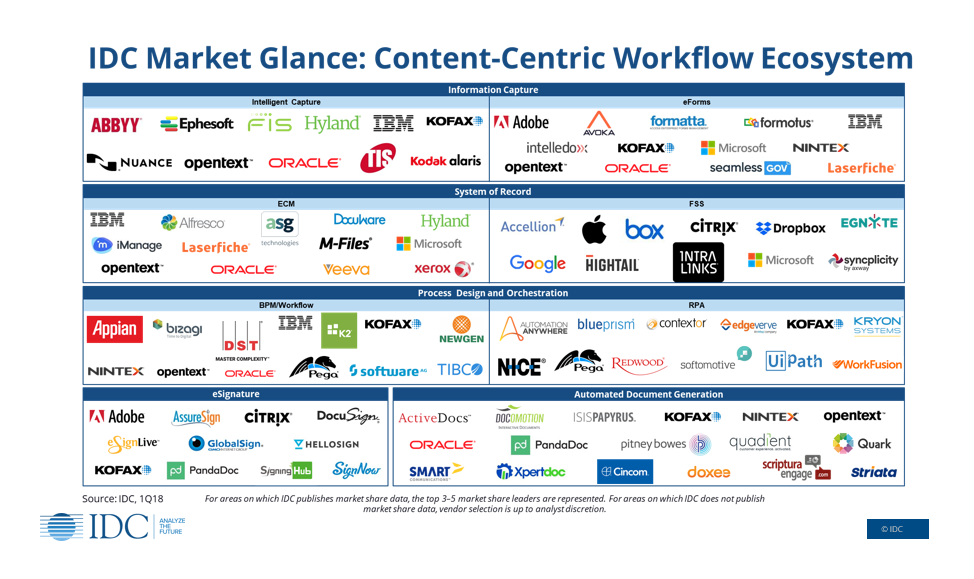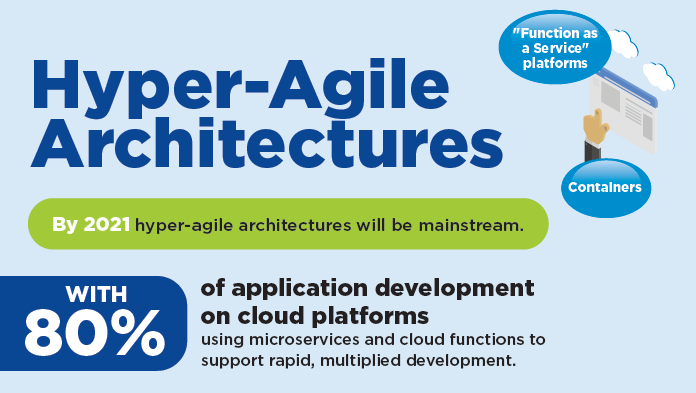IDC has seen a rising buyer interest in cloud app-centric platforms and the agility that the cloud affords. Recently at the IDC Directions 2019 conference, IDC presented on Multiplied Innovation: Scaling a Technology Revolution outlining new technologies that innovate at scale which underpin the growth of cloud applications into the future. This trend is reflected in many traditional Enterprise Content Management applications found in the IDC Market Glance: Content-Centric Workflow Ecosystem transitioning to cloud content apps to meet this growing demand.

It should be no surprise that organizations have turned a corner regarding a comfort level of deploying mission critical applications in the cloud. Some have enjoyed real cost savings by moving traditional content and workflows to cheaper, more elastic and worldwide cloud accessible platforms while assembling only the functional services they need to run their business.
The IDC CloudView Survey, April 2018 found that 26% of organizations want to move their enterprise content solution to the cloud in the next 24 months and remain confident that strong data security and compliance is provided regionally where they need it. Operating with a modern set of capabilities that put emphasis on “content in motion” rather than “content at rest”, cloud content apps have a strong foundation for basic content management, content-centric workflow, interoperability, security, collaboration, analytics and a modern user interface that is enhanced by artificial intelligence (AI), machine learning (ML), mobile and social aspects.
The Benefits of Agile Cloud Content Apps
The new cloud content apps have an opportunity to leverage the elasticity and agility of the cloud to become future hyper-agile content apps. With hyperscale datacenters like Google, Microsoft and Amazon, cloud content apps can easily support a variety of storage and workload hardware to respond automatically to the ebb and flow of seasonal, batch or transactional content demands.
With hyper-agile architectures that embody containers, microservices and cloud functions, cloud content apps will benefit in allowing non-developers to assemble components to meet specific organization needs and add valuable business logic on top. Ad hoc solutions can be assembled that favor specific industry (healthcare or financial services) or organization domain roles (legal or accounting) sharing the content, repositories and cloud benefits to handle multiple use cases. Cloud content apps built on microservices and container architectures can avoid deploying the unnecessary weight of a monolithic application and reduce the need to update the entire application when only one service needs to be revised.

Maturity Matters
In the IDC MaturityScape Benchmark: Managing Enterprise Content in the United States 2018 report, which assess an organization’s current state and readiness of their content management infrastructure to support digital transformation initiatives, IDC found that 22.7% of organizations were at a highest level of maturity for which they are embracing and experimenting with cloud-enabled and AI-enabled technologies.
App-centric platforms and cloud native applications will provide agility and flexibility of managing unstructured content across diverse technology ecosystems and use cases. Over the next 5 years, there will be a growth in new apps that utilize hyper-agile architectures and encourage intelligent automation with machine learning, insights from AI and IoT data, and the application of blockchain beyond crypto-currency to secure personal and business data. Emerging examples in elasticity and scaling of data storage and archival can already be found in the cloud app marketplace.
We are on the precipice of agile workload processing across a global setting being provided by cloud content apps that leverage the foundations of cloud architecture in hyper-scaling and hyper-agile developments.
Learn more about cloud and its role in multiplied innovation; listen to IDC’s Frank Gens discuss how multiplied innovation will become mainstream within the next five years:




